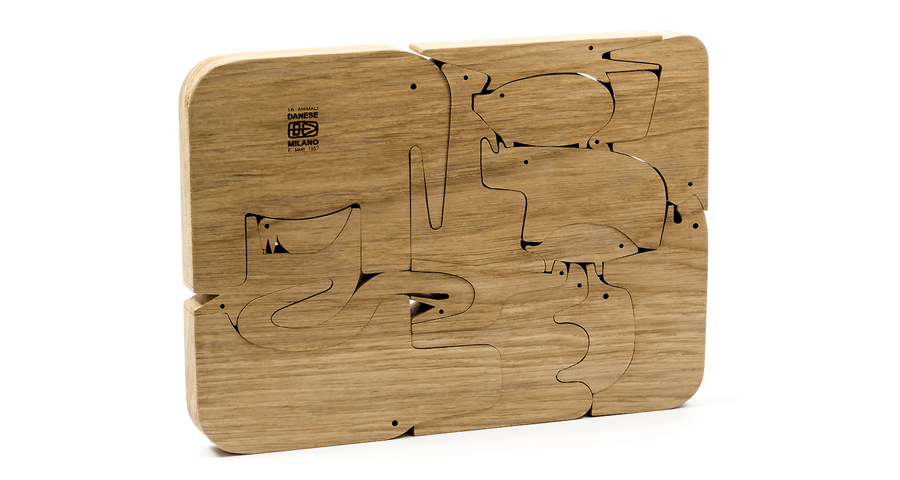Future Exhibition 2024
Discover: 5 things to know about Enzo Mari
On this page, find out more about one of the most significant designers of the 20th century, pioneer of post-war Italian design.
Our current exhibition Enzo Mari curated by Hans Ulrich Obrist with Francesca Giacomelli is open until 8 September 2024. Produced by Triennale Milano, it celebrates Mari’s extraordinary life and legacy bringing together hundreds of his projects including furniture, children’s books and games, product and graphic design and conceptual installation-based works.

Enzo Mari © Ramak Fazel
1. Throughout his career, Enzo Mari created more than 2000 projects
Working almost incessantly for over 60 years, Mari was an intellectual, teacher, artist, exhibition-maker and much more. He always moved freely between disciplines, and saw no distinction between the type of projects he worked on – whether it be furniture, exhibition making, product design, graphic design or artistic installations. His depth of research and relentless rigour produced a body of work like no other – and leaves a legacy that extends far beyond the realm of design.

Formosa perpetual wall calendar, 1963, and Timor perpetual calendar, 1966, Danese Milano
2. Mari studied fine art and stage design
In his early 20s, Mari enrolled at the Brera Academy of Fine Art, where he could be accepted without a high school diploma, as he had had to previously cut short his education in order to support his family. To begin with he studied painting and sculpture, but dropped out of this course as he was unsatisfied with the answers he received to his incessant questions. He finally enrolled in stage design, honing his technical drawing skills and developing his research into visual perception, experimenting with colour, volume, form and depth. Mari designed and won awards for his sets for operas by Puccini and Calderón de la Barca.
3. He made designs for children, and advocated for the importance of play
Mari thought play was not a form of amusement, but a way to understand the world. He famously said that the Nobel Prize should be awarded to two-year-olds, because he was fascinated by how quickly children learn about the world through a process of trial-and-error. As a young father in the 1950s, he noticed that many toys did not encourage creative thinking or autonomy in children, and observed how his own children’s enjoyment came from games that granted freedom in play. At first produced on a relatively small scale, Mari designed some of the most iconic children's puzzles and books that are still in production today.

16 Animali (16 Animals), interlocking game produced by Danese Milano, 1959, photo by Federico Villa
4. For Mari, design was a means to transform society
Among his contemporaries, Mari was known as ‘design’s conscience’. His lifework was advocating for the social responsibility of design and designers, who for him ought to be at the service of society, not themselves. He also thought design should elevate the experience and status of the people producing objects, and not just serve those that bought them. In fact, many of his projects were experiments in de-alienating production line work, or in restoring autonomy and creativity in workers. For Mari, these were ways to practice equality, raise collective consciousness, and ultimately transform society to be more equitable.
5. He continues to be a role model for younger designers
Mari foresaw the ecological and societal dangers of our consumerist society and our throwaway culture. For him, the only real key to a sustainable future was producing less. At a time where surplus and inequality in distribution of goods is as acute as ever, Mari’s reflections on what good design is and should be, resounds far and wide. Generations of younger designers across continents - whether his former students or simply admirers - continue to reference his ethos, by challenging production processes, striving for essential and durable forms, or advocating for the importance of play. Mari’s donation of his archive to the city of Milan is also a gift to younger generations, whom he always believed in and whom he hoped would take learnings and inspiration from his work.
The final room of our exhibition will present a selection of works by contemporary artists and designers, such as Rirkrit Tiravanija and Virgil Abloh, who Hans Ulrich Obrist invited to pay homage to Enzo Mari.
The exhibition
Enzo Mari
Curated by Hans Ulrich Obrist with Francesca Giacomelli
This major exhibition will celebrate the life and work of one of the greatest Italian designers of the 20th century, Enzo Mari, whose designs have inspired generations of creatives around the world.
Members go free
Enjoy a year of free unlimited access to all exhibitions for you and a guest and up to 3 children, priority booking to our programme of events, discounts in the shop and more. Join Membership Plus annually for £75, or £65 by Direct Debit. Are you a student? Join Student Membership for only £45. Gift Membership also available.